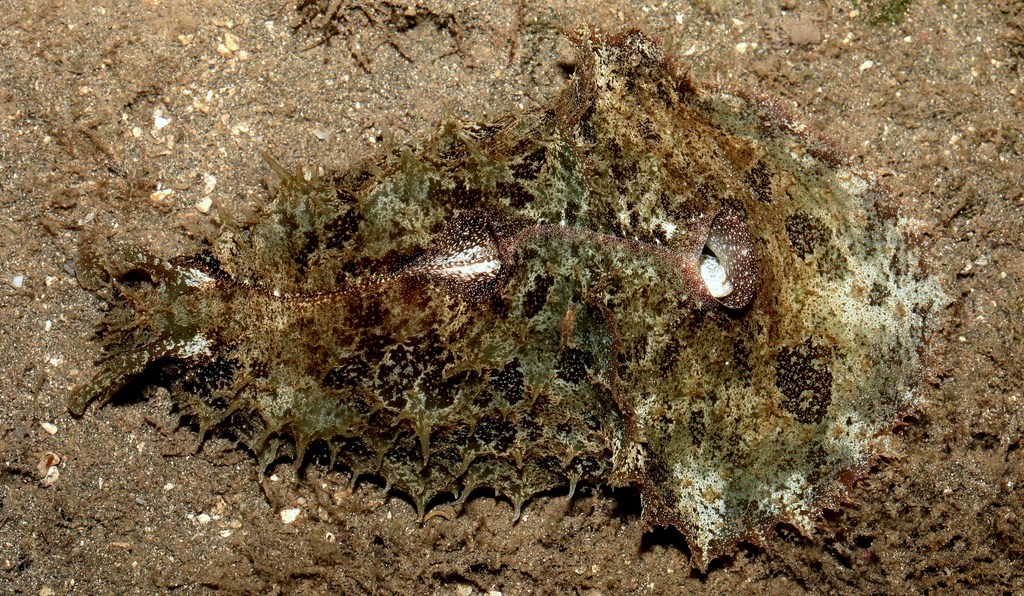DOLABELLA AURICULARIA - (LIGHTFOOT, 1786)
Mollusca (Phylum) > Gastropoda (Class) > Heterobranchia (Subclass) > Euthyneura (Infraclass) > Tectipleura (Subterclass) > Aplysiida (Order) > Aplysioidea (Superfamily) > Aplysiidae (Family) > Dolabella (Genus)
Lièvre de mer à oreille, Dolabelle commune, Dolabelle auriculée, Blunt-end sea hare, Wedge seahare, Eared sea hare, Shoulder-blade sea cat, Hatchet sea hare, Liebre de mar, Lepre di mare, Biete Seehase,
Description
Espèce présente dans les herbiers et les récifs entre 0 et 10 mètres de profondeur.
Espèce présente dans les herbiers et les récifs entre 0 et 10 mètres de profondeur.
Synonymes
Aplysia ecaudata (Rang, 1828)
Aplysia gigas (Rang, 1828)
Aplysia hasseltii (Férussac, 1828)
Aplysia teremidi (Rang, 1828)
Aplysia truncata (Rang, 1828)
Dolabella andersoni (Allan, 1941)
Dolabella callosa (Lamarck, 1801)
Dolabella cheni (W. K. C. Sun, 1960)
Dolabella ecaudata (Rang, 1828)
Dolabella gigas (Rang, 1828)
Dolabella hasseltii (Férussac, 1828)
Dolabella rumphii (Cuvier, 1817)
Dolabella rumphii var. maculosa (Bergh, 1905)
Dolabella scapula (O'Donoghue, 1929)
Dolabella variegata (Pease, 1860)
Patella auricularia ([Lightfoot], 1786)
Patella scapula (Martyn, 1786)
----------------------
Description
Dolabella auricularia is a rather large species. It can reach a length of 40 cm. It can be recognized by a flattened disk on the posterior surface of the animal. This species can be found with soft pustules, leading to a rather knob-like appearance. It has a short, blunt head. Its body is covered with tubercles and skin flaps. The inner shell has a typical earlike form. It gives off purple ink when disturbed. Dolabella is quite variable in colour but it is always mottled shades of green and brown which make it extremely well camouflaged in nature.
Distribution
Dolabella auricularia can be found in the Indian Ocean, Western and North-Western Pacific. Reported from New Caledonia.
Biotop
This sea hare lives in areas that are sheltered from rough currents. They will often hide in seagrass, sand and mud, feeding on algae. Intertidal rock pools are also a favoured place to live.
Biology
Dolabella auricularia is sometimes used by keepers of large marine aquaria, to keep algal growths in the tank down, because the sea hare feeds on them. In the Philippines the eggs of the Sea Hare which they call a Donsol are eaten as a delicacy. This delicacy is called in the Philippines Lukot or Lokot. The anti-cancer agent monomethyl auristatin E is derived from peptides found in Dolabella auricularia.
Aplysia ecaudata (Rang, 1828)
Aplysia gigas (Rang, 1828)
Aplysia hasseltii (Férussac, 1828)
Aplysia teremidi (Rang, 1828)
Aplysia truncata (Rang, 1828)
Dolabella andersoni (Allan, 1941)
Dolabella callosa (Lamarck, 1801)
Dolabella cheni (W. K. C. Sun, 1960)
Dolabella ecaudata (Rang, 1828)
Dolabella gigas (Rang, 1828)
Dolabella hasseltii (Férussac, 1828)
Dolabella rumphii (Cuvier, 1817)
Dolabella rumphii var. maculosa (Bergh, 1905)
Dolabella scapula (O'Donoghue, 1929)
Dolabella variegata (Pease, 1860)
Patella auricularia ([Lightfoot], 1786)
Patella scapula (Martyn, 1786)
----------------------
Description
Dolabella auricularia is a rather large species. It can reach a length of 40 cm. It can be recognized by a flattened disk on the posterior surface of the animal. This species can be found with soft pustules, leading to a rather knob-like appearance. It has a short, blunt head. Its body is covered with tubercles and skin flaps. The inner shell has a typical earlike form. It gives off purple ink when disturbed. Dolabella is quite variable in colour but it is always mottled shades of green and brown which make it extremely well camouflaged in nature.
Distribution
Dolabella auricularia can be found in the Indian Ocean, Western and North-Western Pacific. Reported from New Caledonia.
Biotop
This sea hare lives in areas that are sheltered from rough currents. They will often hide in seagrass, sand and mud, feeding on algae. Intertidal rock pools are also a favoured place to live.
Biology
Dolabella auricularia is sometimes used by keepers of large marine aquaria, to keep algal growths in the tank down, because the sea hare feeds on them. In the Philippines the eggs of the Sea Hare which they call a Donsol are eaten as a delicacy. This delicacy is called in the Philippines Lukot or Lokot. The anti-cancer agent monomethyl auristatin E is derived from peptides found in Dolabella auricularia.
